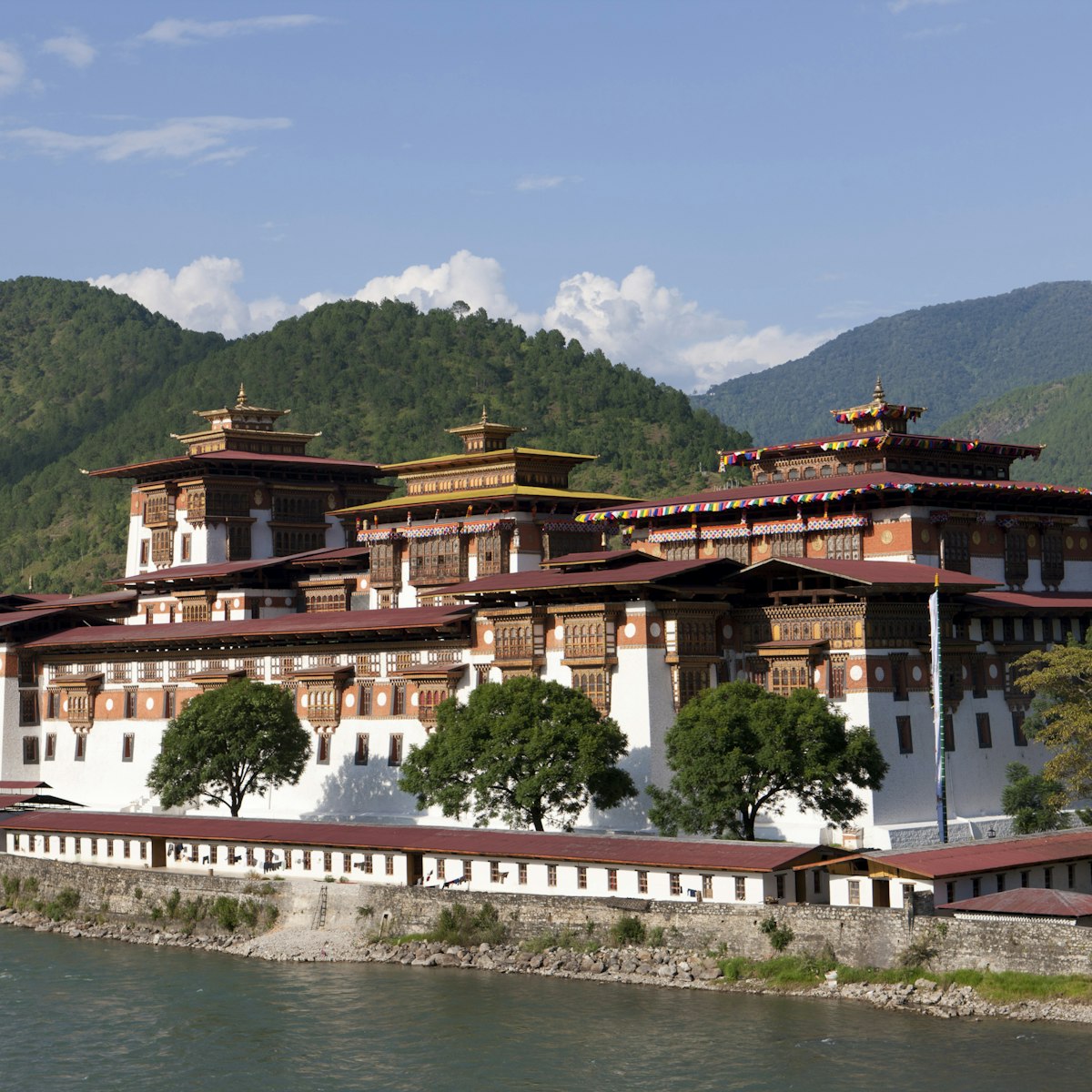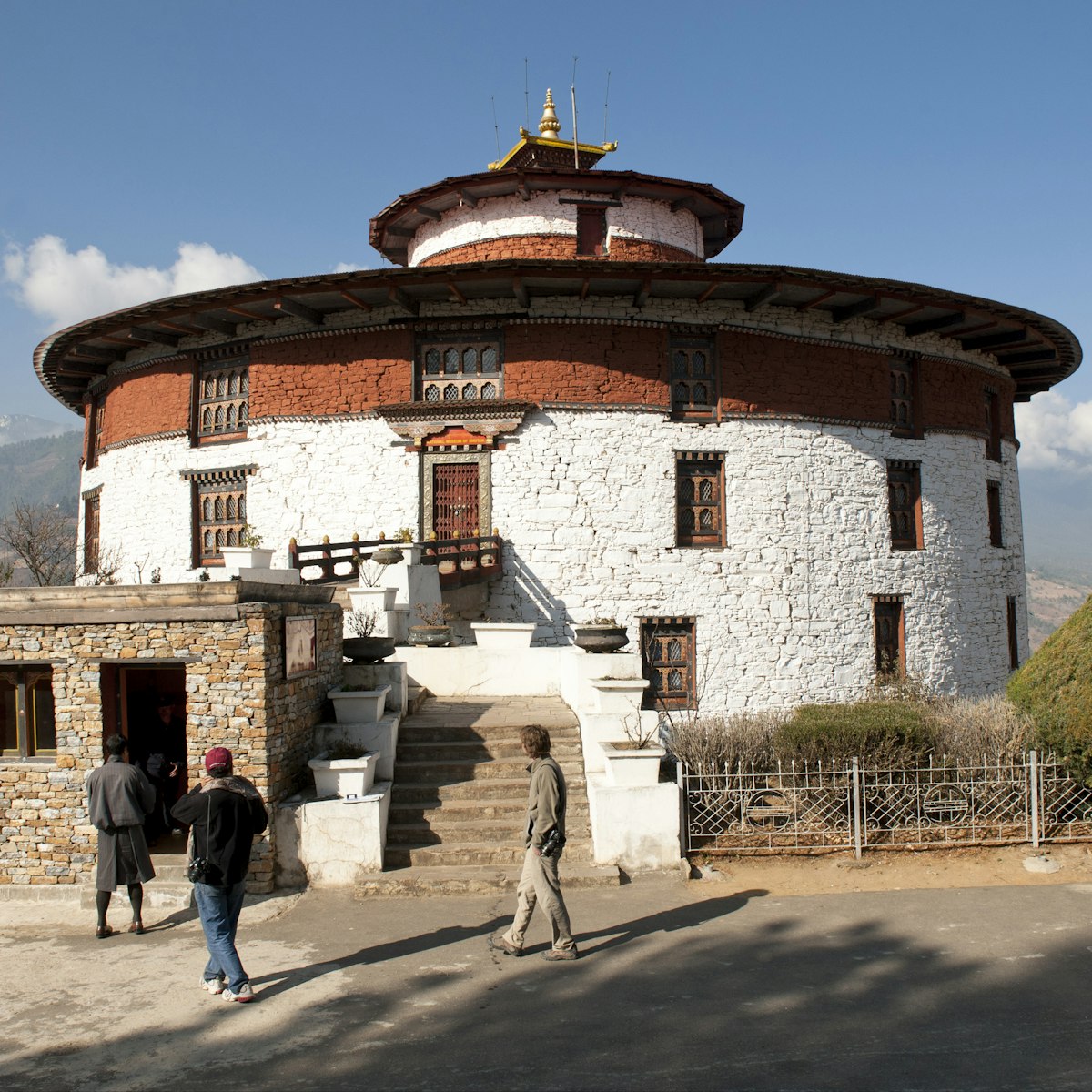This splendid dzong, north of the city on the west bank of the Wang Chhu, dominates the valley, looking out over a cascade of terraced fields. It's Thimphu's grandest building by far, and served as the official seat of the Druk Desi, the head of the secular government that shared power with the religious authorities, from the 18th to the 19th centuries. The dzong was the site of the lavish formal coronation of the fifth king in 2008.
The building you see today is actually not the original Thimphu dzong. The first fortress – the Dho-Ngen Dzong (Blue Stone Dzong) – was erected in 1216 on the hillside where Dechen Phodrang now stands, and it was adopted as the seat of Lama Phajo Drukgom Shigpo, who brought the Drukpa Kagyu lineage to Bhutan. The fort was renamed Trashi Chho Dzong (Fortress of the Glorious Religion) when it passed from the descendants of Lama Phajo to Zhabdrung Ngawang Namgyal in 1641.
The Zhabdrung planned to house both monks and civil officials in the dzong, but it was too small, so he built a new dzong lower down in the valley for the civil officials, and this soon become the focus of attention. The upper dzong was eventually destroyed by fire in 1771 and the lower dzong was expanded before also suffering a devastating fire in 1866. Such setbacks are not unusual in the history of a dzong, and the lower dzong was rebuilt, before suffering damage in two further fires and the deadly earthquake of 1897.
When King Jigme Dorji Wangchuck moved his capital to Thimphu in 1962, he began a five-year project to renovate and enlarge the dzong. The royal architect left the utse (central tower) untouched, along with the imposing chapel and assembly hall in the courtyard, but the rest of the compound was rebuilt in traditional fashion, without nails or architectural plans. The dzong once housed the National Assembly and now houses the secretariat, the throne room, and offices of the king and the ministries of home affairs and finance. The courtyard to the north of the assembly hall hosts Thimphu's biggest annual bash, the colourful tsechu festivities.
The dzong's whitewashed perimeter walls are guarded by three-storey towers at the four corners, capped by red-and-gold, triple-tiered roofs. The only way to enter the fort is via one of two gateways on the eastern side of the structure. The southern entrance leads to the administrative section (off-limits to visitors), while the northern entrance leads to the monastic quarter, the summer residence of the dratshang (central monk body).
Entering the dzong via the northern entrance after a thorough security check, visitors are greeted by depictions of the four guardian kings, while the steps are flanked by images of Drukpa Kunley, Thangtong Gyelpo and Togden Pajo (the founder of nearby Phajoding Monastery). Beyond is the vast, flagstone dochey (courtyard) and the utse. It's hard not to be humbled by the dramatic proportions of the architecture, and the enclosed silence broken only by the flight of pigeons, the shuffle of feet and the whir of prayer wheels.
The northern part of the compound, which visitors are free to explore, contains the towering utse, accessed via a steep wooden stairway. If you're allowed in, look for the 3rd-floor funeral chorten of the 69th Je Khenpo, where pilgrims receive the blessing of betel nut from his nut container. If this intrigues you, head next door to visit the toilet of the Zhabdrung in his former living room.
Nearby in the courtyard is the Lhakhang Sarp, a small chapel with handsome mythical beasts supporting its beams. The original dukhang (assembly hall) on the edge of the square enshrines a huge statue of Sakyamuni (the historical Buddha) and the thrones of the current king, past king and Je Khenpo. Look to the ceiling for fine mandala paintings.
Northeast of the dzong is an excellent example of a traditional cantilever bridge. To the southeast is the unassuming residence of the current king, while across the river you can see the impressive, step-roofed National Assembly. The small Neykhang Lhakhang, west of the dzong, houses the local protective deities Gyenyen Jagpa Melen and Dorji Daktshen, and is off-limits to visitors.
The large open-air courtyard on the north side of the dzong hosts the dances of the annual tsechu festival in September. The dzong's huge Sangay Tsokhorsum Thondrol (painted/embroidered religious picture) is unfurled here at the climax of the tsechu.






